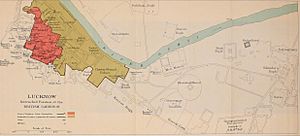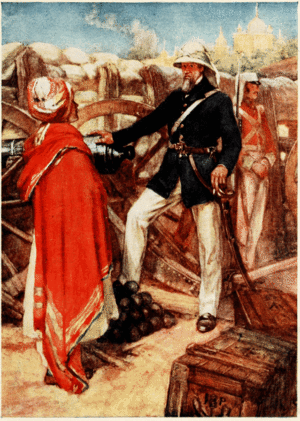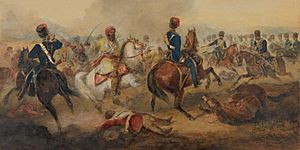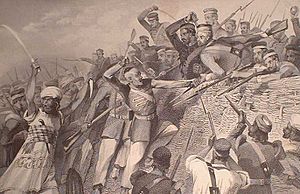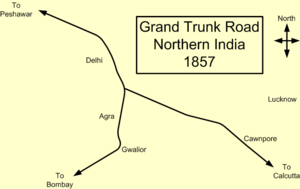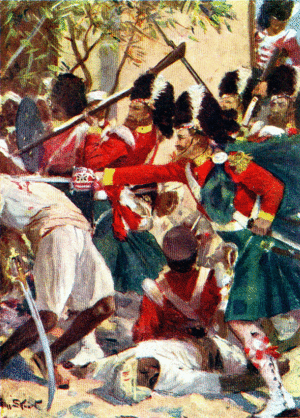Siege of Lucknow facts for kids
Quick facts for kids Siege of Lucknow |
|||||||
|---|---|---|---|---|---|---|---|
| Part of Indian Rebellion of 1857 | |||||||
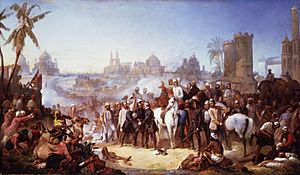 The Relief of Lucknow, by Thomas Jones Barker |
|||||||
|
|||||||
| Belligerents | |||||||
| Commanders and leaders | |||||||
|
Various commanders including:
|
||||||
| Strength | |||||||
| 1,729 troops, rising to approx. 8,000 | 5,000 men, rising to approx. 30,000 | ||||||
| Casualties and losses | |||||||
| 2,500 killed, wounded, missing | unknown | ||||||
The Siege of Lucknow was a long fight in 1857 during the Indian Rebellion of 1857. It happened in the city of Lucknow, India. British soldiers and civilians were trapped inside a building called the Residency. They were surrounded by Indian soldiers, known as sepoys, who had rebelled against the British East India Company.
The people inside the Residency defended themselves for many weeks. Two different British armies tried to rescue them. After the second rescue team arrived, everyone inside the Residency was safely moved out. The Residency was then left empty.
Contents
Why the Siege Happened
The British East India Company had taken over a state called Oudh (also known as Awadh) in India. They sent its ruler, Wajid Ali Shah, away to another city. Many people in Oudh and other parts of India were very unhappy about this.
Indian soldiers, or sepoys, working for the British East India Company were also upset. They felt that their religions and traditions were being threatened. Sir Henry Lawrence, a British leader, knew that the Indian troops were restless.
A big problem came when new rifle cartridges were given out. Soldiers believed these cartridges were greased with animal fat, which was against their religious beliefs. This made many Hindu and Muslim soldiers very angry. On May 10, 1857, Indian soldiers in Meerut openly rebelled and marched to Delhi. When this news reached Lucknow, Sir Henry Lawrence quickly started getting the Residency ready for a fight.
The Rebellion Begins
On May 23, Sir Henry Lawrence began making the Residency stronger and storing food. Many British civilians from nearby areas came to the Residency for safety. On May 30, most of the Indian troops in Lucknow rebelled. Lawrence had some British soldiers and loyal Indian soldiers. They managed to push the rebels away from the city for a short time.
Soon, rebellions broke out in other important cities around Lucknow. Within ten days, the British lost control of almost all of Oudh.
On June 30, Lawrence heard that rebels were gathering north of Lucknow. He led his troops out to check, even though he didn't have much information. His soldiers marched in the hot sun without enough food or water. At the Battle of Chinhat, they met a strong rebel army. Some of Lawrence's Indian soldiers even switched sides during the battle. His tired British soldiers had to retreat quickly.
Lieutenant William George Cubitt was very brave during this retreat. He saved three British soldiers and was later given the Victoria Cross medal. Other loyal Indian soldiers also saved many British lives.
Because of this defeat, a building called Machchhi Bhawan, which held a lot of gunpowder, was blown up. The British soldiers then went back inside the Residency.
First Attacks on the Residency
The siege of the Residency now truly began. The British set up their defenses around the Residency and a few other buildings. This area was about 60 acres wide. There were not enough soldiers (about 1,700 fighters) to defend it well against a big attack. Also, many large palaces and buildings were close by. These gave the rebels good places to hide and shoot from.
On July 1, the first big attack by the rebels was stopped. The next day, Sir Henry Lawrence was badly hurt by a cannon shell. He died on July 4. Colonel John Eardley Inglis took over as the military leader.
About 8,000 rebel sepoys and other fighters surrounded the Residency. They had many guns, some modern and some old. They tried several times to storm the defenses, but they couldn't work together well enough.
The British defenders, whose numbers kept shrinking due to fighting and sickness, managed to stop all the rebel attacks. They also dug tunnels to fight the rebels underground. Several soldiers were awarded the Victoria Cross for their bravery during these fights.
First Rescue Attempt
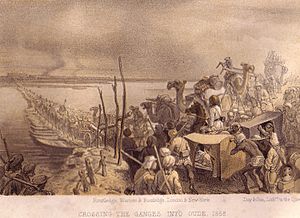
On July 16, a British force led by Major General Henry Havelock took back the city of Cawnpore, which was about 48 miles from Lucknow. Havelock decided to try and rescue the people in Lucknow. It took him six days to get his 1,500 men across the Ganges River.
On July 29, Havelock won a battle near Unnao. But his force became too small because of injuries, sickness, and heat. He had to turn back. Havelock sent a spy to the Residency to tell them he was coming. He said they would fire two rockets when his rescue force was ready to attack.
Havelock tried to advance again after getting more soldiers. He won another battle on August 4, but still wasn't strong enough to reach Lucknow. He had to retreat across the Ganges River.
Havelock's retreat was necessary, but it made the rebellion in Oudh even bigger. More local landowners joined the rebels.
First Rescue of Lucknow
Major General Sir James Outram took over command from Havelock. But Outram let Havelock lead the rescue force. The force had 3,179 soldiers, including British and Sikh troops.
They started moving on September 18. This time, the rebels didn't fight much in the open. On September 23, Havelock's force pushed the rebels out of the Alambagh, a walled park near Lucknow. They left their supplies there and began the final push on September 25.
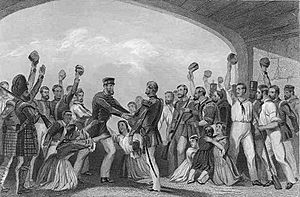
The soldiers faced heavy fighting as they crossed the Charbagh Canal. They then moved through narrow, heavily defended streets. Many soldiers were killed, including Brigadier James George Smith Neill. The rescue force lost 535 men in this final push.
By the time the rescue force reached the Residency, the defenders had been under siege for 87 days. They were down to only 982 fighting men.
Second Siege Begins
Outram had planned to take everyone out of the Residency. But so many soldiers were lost during the rescue that it was impossible to move all the sick, wounded, and civilians. They also found a large amount of food and supplies under the Residency, enough for two months. So, they decided to stay.
The defended area was made larger. Inglis still led the original Residency area, and Havelock took charge of the palaces nearby. Outram hoped the rescue would make the rebels give up, but it didn't. For the next six weeks, the rebels kept shooting at the defenders and digging tunnels under them. The defenders fought back with their own attacks and tunnels.
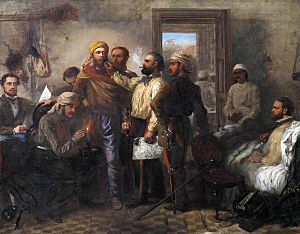
Messages could be sent between the Residency and the Alambagh. A brave civilian named Thomas Henry Kavanagh dressed up as an Indian soldier. He left the Residency with a local guide and reached the Alambagh. He helped guide the next rescue attempt. Kavanagh was the first civilian in British history to win the Victoria Cross for his actions in a military conflict.
Planning the Second Rescue
The rebellion was happening across a very large part of northern India. Many rebels had gone to Delhi, where they tried to bring back the old Mughal Empire. A British army had surrounded Delhi and captured it by September 21.
Later, a British force under Colonel Greathed was sent to restore British rule from Delhi to Cawnpore. This force helped a British group trapped in the Red Fort at Agra.
Soon, Sir Colin Campbell arrived in India to take command of the army. He reached Cawnpore in early November. Campbell decided to go straight to Lucknow to rescue the people there. He left 1,100 soldiers to defend Cawnpore and took 4,100 men and 42 guns towards Lucknow.
British warships even sent their sailors and guns to help Campbell's force. These sailors formed a "Naval Brigade" and fought their way from Calcutta.
The rebels surrounding Lucknow were estimated to be between 30,000 and 60,000 strong. They had good weapons and had improved their defenses. However, they lacked a single leader, which made them less effective.
The Second Rescue Mission
On November 14, Campbell began his rescue of Lucknow. He had learned from the first rescue attempt. Instead of going through the narrow streets, he decided to go around the east side of the city. He planned to secure each position as he advanced to protect his supplies. He would then capture a walled garden called the Secundra Bagh and connect with the Residency.
Campbell's column faced little resistance at first. They quickly took Dilkusha Park and La Martiniere (a school). By noon, these places were in British hands. The rebels attacked the British from a building called Bank's House, but the British pushed them back.
Campbell's force had moved very quickly, leaving their supplies behind. They had to wait for food, ammunition, and medical gear to catch up. On the evening of November 15, they sent a signal to the Residency: "Advance tomorrow."
The next day, the rescue column moved towards the Secundra Bagh.
Fighting at Secundra Bagh
The Secundra Bagh was a large, high-walled garden. Campbell's soldiers faced heavy gunfire from the garden and nearby buildings. British cannons were brought up close and fired at the walls. They made a hole in the southeastern wall.

Soldiers from the Scottish 93rd Highlanders and the 4th Punjab Infantry Regiment rushed forward. The hole was too small, so the Punjab Infantry went to the main gate and took it over. Once inside, they fought hand-to-hand. The Highlanders poured in, shouting, "Remember Cawnpore!" (referring to a massacre there). The fighting was fierce. Nearly 2,000 rebel soldiers were killed.
Taking the Shah Najaf
Later that day, a part of Campbell's force moved towards the Shah Najaf. This was a walled mosque and tomb that the rebels had made very strong. The rebels fired heavily from this building and from other cannons nearby. For three hours, the British fired their cannons at the strong walls of the Shah Najaf, but the walls did not break. Many British soldiers were lost.
Fifty Highlanders went to find another way into the Shah Najaf. They found a small hole in a wall, made it bigger, and got inside. They opened the main gates, and their comrades rushed in. By nightfall, Campbell had set up his headquarters inside the Shah Najaf.
Reaching the Residency
Inside the besieged Residency, Outram and Havelock were ready to meet Campbell's army. They blew up the outer walls of their garden when they saw that the Secundra Bagh was taken.
The Moti Mahal, the last big building between the two British forces, was cleared by Campbell's soldiers. Only about 450 yards separated them now. Outram, Havelock, and other officers ran across this open space to talk with Campbell. Even though the rebels kept fighting hard, the British cleared the last areas of resistance. The second rescue force had finally reached the Residency!
The Evacuation
Outram and Havelock wanted to attack the Kaisarbagh palace. But Campbell knew that other rebel forces were threatening Cawnpore. So, he ordered everyone to leave Lucknow. The evacuation began on November 19.
While Campbell's cannons fired at the Kaisarbagh to trick the rebels, large canvas screens were put up. These screens hid the open space from the rebels' view. The women, children, and sick and wounded people moved safely to Dilkusha Park behind these screens. Over the next two days, Outram disabled his guns and followed them.
At Dilkusha Park, Havelock died on November 24 from a sudden illness. The entire army and the rescued people then moved to the Alambagh. Campbell left Outram with 4,000 men to defend the Alambagh. Campbell himself took 3,000 men and most of the civilians to Cawnpore on November 27.
What Happened Next
The first siege of Lucknow lasted 87 days, and the second siege lasted another 61 days.
The rebels controlled Lucknow for the next winter. But they couldn't do much because they weren't united, and Outram held the Alambagh. Campbell returned to take back Lucknow. The final attack started on March 6, 1858. By March 21, all fighting had stopped.
During the siege, the Union Jack (British flag) flew day and night at the Residency. This was unusual, as flags are usually taken down at dusk. After the British took back Lucknow, they were given special permission to fly the Union Jack 24 hours a day at the Residency. This was unique in the British Empire. The day before India became independent, the flag was lowered, and the flagpole was removed so no other flag could ever fly there.
Many Victoria Crosses were given out during the second rescue. On November 16, 24 Victoria Crosses were awarded, mostly for the attack on the Secundrabagh. One of the winners was William Hall, a Black Nova Scotian. He kept firing a gun at the Shah Najaf even after almost all his crew mates were killed.
The Indian Mutiny Medal had three special badges for Lucknow:
- Defence of Lucknow: For those who defended the Residency from June 29 to November 22, 1857.
- Relief of Lucknow: For the rescue force in November 1857.
- Lucknow: For troops who helped capture Lucknow in November 1857.



